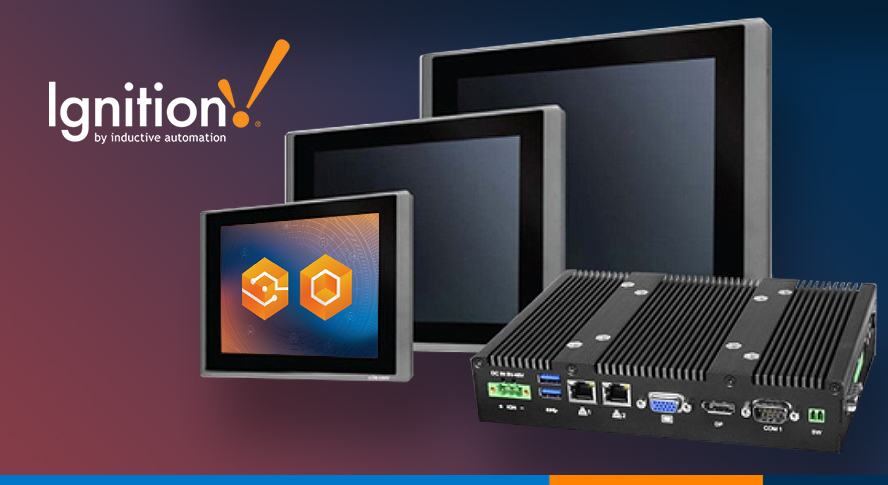3 Things to Consider when Choosing a HMI PC for Ignition
So, you’ve selected Ignition from Inductive Automation as your primary platform for your SCADA/HMI/MES system. Now the question is, “For my end-use clients, what HMI PC do I need to deploy for Perspective® or Vision?” The answer will come from fully understanding how you and/or your end users intend to use the system.
Projects generally fall into one of three groups:
- Touchscreen HMI
- Display with Keyboard or Display Only
- Control Room Multi-Monitor Setup
No matter which group your project falls into, the questions you’ll need to answer to guide your HMI PC selection are generally the same.
How much performance do I need?
A system running exclusively Perspective or Vision Ignition software modules won’t require a huge amount of processing power and only around 4GB of RAM. Systems powered by an Intel Celeron® N3350 or Atom® E3950 provide ample horsepower for HMI deployments. If other applications are running on the client as well, such as corporate mandated security applications or video conferencing software, you will want to investigate more powerful options and consider stepping up the RAM. Additionally, if you’re looking into a Thin Client program such as ThinManager, make sure those applications support Ignition before making your hardware choice.
Connectivity options are part of the performance consideration. Generally speaking, both Perspective and Vision can use either hardwired ethernet or wi-fi depending on your install location. However, if using Ignition Edge Panel running locally on the PC, you have the ability to store and forward tags, so you may also want to consider 4G LTE for remote installations.
What type of environment will I be deploying this solution into?
All too often, the environment hardware will be installed in is overlooked as a key consideration when choosing SCADA hardware. Here are a few of the environmental factors you’ll want to account for when deploying systems:
Dust and Particulate
Your standard desktop PC has fans to draw in and circulate air in order to cool the system. A fanless PC cools using convection or other heat dissipation methods and doesn’t require openings in the case to let air in or out. If your environment is subject to airborne particulate, fanless PCs can help prevent downtime due to contaminant ingress. As an example, cabinet manufacturing specialists, American Woodmark, discovered just how much they could save when fanless PCs reduced failure and maintenance downtime.
Temperature
Spaces without heating or cooling available, or that need to operate at extreme temperatures, will need a ruggedized system designed to operate in those temperatures. Systems rated for operation in temperatures from -40° to 70°C, or an application-appropriate subset of that range, would be a good fit. While this environmental consideration is most apparent in extreme outdoor environments, it can be just as important in indoor deployments as well. From cold chain management to foundries and forges, indoor environments can experience extreme temperature conditions. If your application requires operation in more moderate, but still uncomfortable temperatures, consider an industrial PC which generally has an operating temperature range of around 0-50°C.
Shock/Vibration
An automotive HMI, like one on a large piece of mining equipment for example, shouldn’t utilize an off the shelf PC with moving parts such as fans or hard drives. Even “standard” industrial computers could have internal cabling that might shake loose. Make sure to select a PC that has shock and vibration ratings, such as MIL-STD-810 or IEC 60068. Paired with solid state drives, the whole system is built to last, even in these unstable conditions.
Power Input
You don’t always have access to an AC wall outlet. Your specific power setup will have a serious impact on your HMI PC of choice. For industrial installations, it’s best to look for a PC that can take a range of direct DC voltage. Even better if it has a terminal block style connector to make wiring easier.
What regulations or compliances do I need to consider for my HMI PC?
If you need UL 62368-1 safety testing or specific certifications like Class 1 Division 2, take that into account for your hardware search. If you’re unsure, make sure to ask the responsible regulatory engineer in your company what’s needed. The wrong regulation can be a major roadblock for your project. OnLogic has experienced regulatory professionals and engineers who can help you ensure compliance.
These are just some of the considerations you need to make when deploying a HMI PC for use with Ignition. We’re happy to talk through what hardware can best fit your needs, or those of your end users.
Editor’s Note: Inductive Automation has ended their Ignition Onboard program. Ignition licenses must now be purchased directly through Inductive Automation. While the IGN versions of our solutions are no longer available, our computers remain a great fit for use with Ignition software. Explore our recommended hardware here.
Get the Latest Tech Updates
Subscribe to our newsletters to get updates from OnLogic delivered straight to your inbox. News and insights from our team of experts are just a click away. Hit the button to head to our subscription page.
Share
More Articles
OnLogic Industrial Computers
Discover OnLogic's multitude of industrial computers that will help you to advance your IoT project
Learn more at OnLogic.com
OnLogic Industrial PCs: Designed to last. Built to order. Delivered in days. Visit our online store at OnLogic.com





